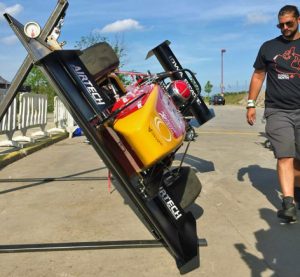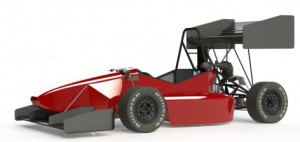
This story was originally posted by Mike Krapfl with the Iowa State News Service.
Roger Steinforth has been through all the data from all the computer simulations. And he thinks adding wings to Cyclone Racing’s mini open-wheel racer could cut lap times by a second or two.
That’s a big performance boost for the student-designed and student-built race cars of the formula racing series sponsored by SAE International, formerly the Society of Automotive Engineers.
“Our main goal is to achieve as much downforce as possible with minimal drag,” Steinforth said as he showed off the dual-element wings made from carbon fiber and Nomex®. “We want to improve our top speeds in the turns.”
Adding those wings is a big step for the student-engineers of Iowa State’s Formula SAE Team. Iowa State students haven’t designed and built aerodynamic elements for their race car in years, maybe decades. The wings add weight and complexity to the car. The extra downforce also increases drag and reduces top speeds.
But, after looking at the numbers and the performance of competitors, Steinforth thinks it’s a good move.
“We’ve seen other teams with wings and how cool they were, and all the cool things they could do,” said Steinforth, a senior from Cary, Ill., who’s studying mechanical engineering.
And what are those cool things?

“A lot of it is speed around corners,” he said. “I’m hoping these wings will improve lap times by a second or two per lap. That adds up over an endurance race of 14 miles.”
What about the rest of the car? How is it looking this year?
Derek Peters – a May graduate from Hartley who will soon leave Ames for an engineering job with Oshkosh Defense in Wisconsin – said the team has been careful to learn from past mechanical problems.
Problems with broken fuel injector mounts have been fixed by adding some aluminum pieces to the assembly. The rear dampers have been moved to the top of the suspension so they’re much easier to adjust and maintain. The Yamaha YFZ450R ATV engine has been lowered a bit, dropping the car’s center of gravity and improving turning speeds.
Peters, a former technical director for the team, thinks the tweaks will make a difference when the team competes this week at Formula North in Barrie, Ontario, Canada, and June 17-20 at Formula SAE Lincoln in Nebraska.
“I think we’ll complete every event this year,” he said, noting the competition’s driving events include acceleration, skid-pad performance, fuel economy, a short autocross race and a long endurance race. “I don’t know how high we’ll place, but I don’t think we’ll have the minor problems that have taken us out the last two years.”